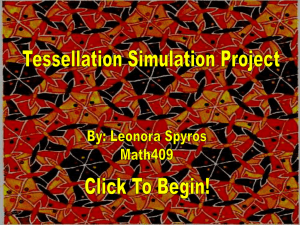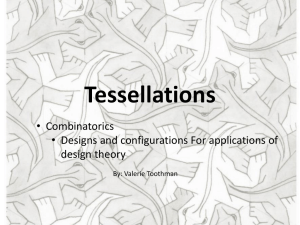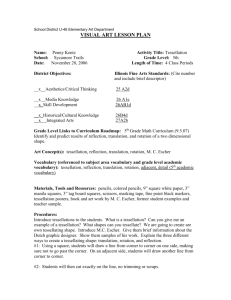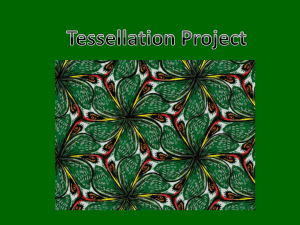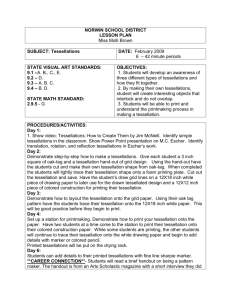Answer Key -- What's Regular About Tessellations?
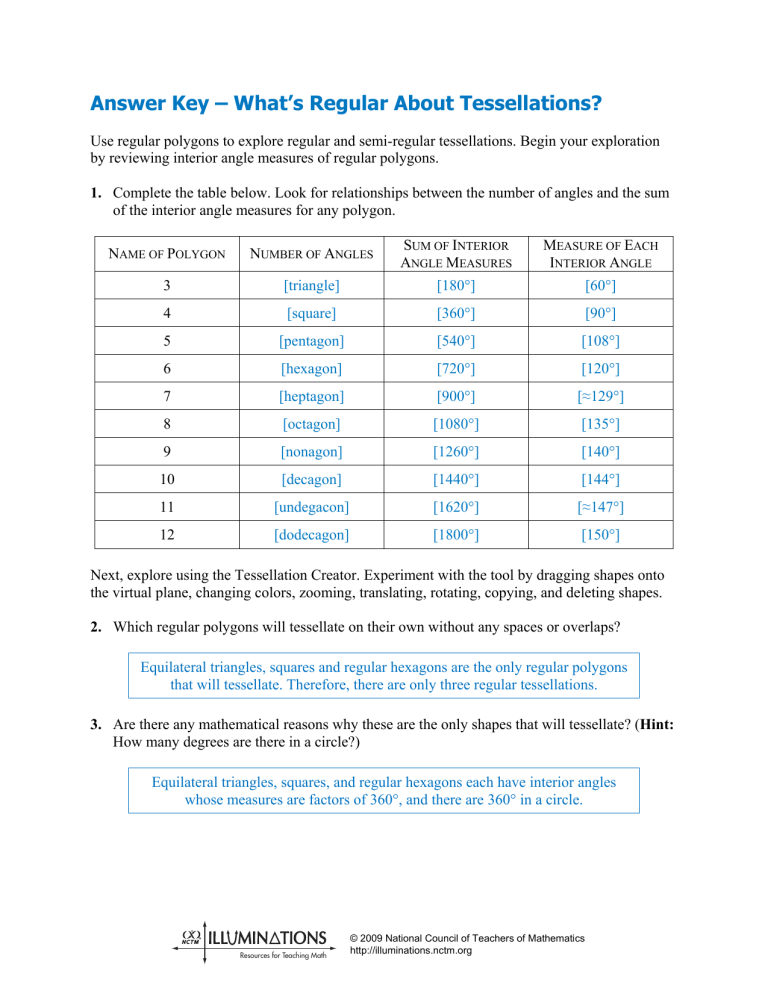
Answer Key – What’s Regular About Tessellations?
Use regular polygons to explore regular and semi-regular tessellations. Begin your exploration by reviewing interior angle measures of regular polygons.
1.
Complete the table below. Look for relationships between the number of angles and the sum of the interior angle measures for any polygon.
N
AME OF
P
OLYGON
N
UMBER OF
A
NGLES
S UM OF I NTERIOR
A NGLE M EASURES
M EASURE OF E ACH
I NTERIOR A NGLE
3 [triangle] [180°] [60°]
4
5
[square]
[pentagon]
[360°]
[540°]
[90°]
[108°]
8
9
6
7
[hexagon]
[heptagon]
[octagon]
[nonagon]
[720°]
[900°]
[1080°]
[1260°]
[120°]
[ ≈ 129°]
[135°]
[140°]
10
11
[decagon]
[undegacon]
[1440°]
[1620°] [
[144°]
≈ 147°]
12 [dodecagon] [1800°] [150°]
Next, explore using the Tessellation Creator. Experiment with the tool by dragging shapes onto the virtual plane, changing colors, zooming, translating, rotating, copying, and deleting shapes.
2. Which regular polygons will tessellate on their own without any spaces or overlaps?
Equilateral triangles, squares and regular hexagons are the only regular polygons that will tessellate. Therefore, there are only three regular tessellations.
3. Are there any mathematical reasons why these are the only shapes that will tessellate? ( Hint:
How many degrees are there in a circle?)
Equilateral triangles, squares, and regular hexagons each have interior angles whose measures are factors of 360°, and there are 360° in a circle.
Resources for Teaching Math
© 2009 National Council of Teachers of Mathematics http://illuminations.nctm.org
4. Is it possible to tile the plane using only regular octagons? Why or why not?
It is not possible to tile the plane using only octagons. Two octagons have angle measures that sum to 270° (135° + 135°), leaving a gap of 90°. Three octagons surrounding a point on the plane would have angle measures that sum to 405°, which would cause an overlap of 45°. Students should begin to see both numerically and visually that 2 octagons and 1 square will surround a point. This question is intended to guide students in thinking about semi-regular tessellations.
In the previous questions you explored regular tessellations. A regular tessellation is a design covering the plane made using 1 type of regular polygons. A semi-regular tessellation is made using 2 or more types of regular polygons. With both regular and semi-regular tessellations, the arrangement of polygons around every vertex point must be identical. This arrangement identifies the tessellation. For example, a regular tessellation made of hexagons
6
6
6 would have a vertex configuration of {6, 6, 6} because three hexagons surround any random vertex.
5. Use the Tessellation Creator to find at least 2 semi-regular tessellations. Sketch them in the table below. Classify each tessellation by listing the clockwise or counterclockwise configuration of polygons surrounding each vertex. An example has been provided for you.
S
KETCH OF
S
EMI
-R
EGULAR
T ESSELLATION
V
ERTEX
C
ONFIGURATION
I
NTERIOR
A
NGLE
M EASURES AND S UM
{3, 6, 3, 6}
60° + 120° + 60° + 120° =
360°
[4, 8, 8]
[90° + 135° + 135° =
360°]
[3, 3, 3, 4, 4]
[(60° × 3) + (90° × 2) =
360°]
Resources for Teaching Math
© 2009 National Council of Teachers of Mathematics http://illuminations.nctm.org
[4, 3, 4, 6]
[90° + 60° + 90° + 60° =
360°]
[4, 6, 12]
[90° + 120° + 150° =
360°]
[3, 4, 3, 3, 4]
[60° + 90 + 60 + 60 + 90 =
360°]
[12, 12, 3]
[150° + 150° + 60° =
360°]
[3, 3, 3, 3, 6] [(60° × 4) + 120° = 360°]
6. Define each of the following terms in your own words. a) regular polygon a polygon having all sides and all interior angles congruent
Resources for Teaching Math
© 2009 National Council of Teachers of Mathematics http://illuminations.nctm.org
b) regular tessellation a tessellation or tiling using only one type of regular polygon c) semi-regular tessellation tessellation or tiling using two or more types of regular polygons d) vertex configuration a series of numbers which represent the arrangement of polygons surrounding any random vertex of a regular or semi-regular tessellation
7.
Jack claims he constructed a semi-regular tessellation with vertex configuration {3, 4, 6}. a) What do the numbers 3, 4, and 6 refer to?
The vertex configuration of {3, 4, 6} refers to an equilateral triangle, square, and regular hexagon surrounding any random vertex point in the tessellation. b) Explain why a semi-regular tessellation with a vertex configuration of {3, 4, 6} would not work.
A {3, 4, 6} vertex configuration will not work because the sum of the interior angle measures of an equilateral triangle, square, and hexagon will sum to
60 + 90 + 120 = 270 °, but for a configuration to tessellate, the sum must be 360°.
c)
How could Jack revise his vertex configuration so that it would correctly represent a semi-regular tessellation?
If Jack added a square to the vertex configuration, the interior angles would sum to 360 ° . This would create the vertex configuration of {3,4,6,4}, which is a semiregular tessellation.
Resources for Teaching Math
© 2009 National Council of Teachers of Mathematics http://illuminations.nctm.org


